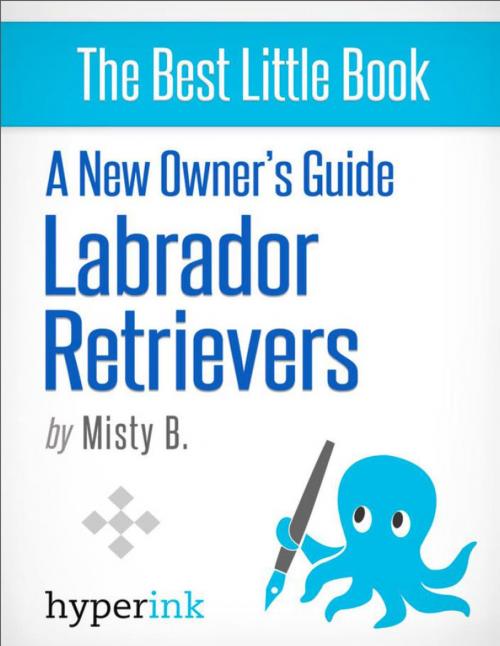A New Owner's Guide to Labrador Retreivers
Nonfiction, Reference & Language, Reference, Guides & Handbooks| Author: | Misty B. | ISBN: | 9781614647317 |
| Publisher: | Hyperink | Publication: | March 14, 2012 |
| Imprint: | Hyperink | Language: | English |
| Author: | Misty B. |
| ISBN: | 9781614647317 |
| Publisher: | Hyperink |
| Publication: | March 14, 2012 |
| Imprint: | Hyperink |
| Language: | English |
ABOUT THE BOOK
The Labrador Retriever, commonly known as the Lab, was originally bred to retrieve fishing nets from the water, and to catch fish which jumped off the hook. The lab insured a greater catch for fishermen who had a retriever in their care. As the breed evolved, Labs rapidly gained popularity as a hunting dog and as a companion. Today, its intelligence and their ability to be trained which have made the breed indispensable in a wide variety of fields.
Raising Labradors is a rewarding experience for a multitude of reasons. First, labs are extremely popular, and thus very easy to market. In fact, according to the American Kennel Club's rankings, they have been the most popular dogs in America for more than 20 years. They are energetic and loyal companions that appeal to a variety of owners because of their varied skill set. They also have a fantastic personality, as they are typically mild-tempered and extremely intelligent.
MEET THE AUTHOR
Misty B. is an experienced writer and a member of the Hyperink Team, which works hard to bring you high-quality, engaging, fun content. Happy reading!
EXCERPT FROM THE BOOK
Some of the most unique and remarkable physical attributes carried by the Lab breed are directly related to their early use by fishermen. The distinct interwoven pattern of their coat has unique waterproof qualities. Moisture will bead up and roll off their coat making it easier for them to swim without resistance. It also provides a unique layer of insulation, as water does not penetrate the inner layers of the coat so that labs stay both dry and warm in damp conditions. Labrador retrievers also have webbed feet which make the excellent swimmers, and which make them more sure-footed on rough or slick terrain. Finally, their tail is wide and flat; designed to be used like a propeller behind the body while swimming.
Basic obedience training should always be completed before expecting a lab to learn a special skill set. Obedience training should begin at about eight weeks and continue until the dog is well behaved and consistently responsive. New skills, which target specialized purposes, like service or hunting, can then be added.
There is a separate and distinct set of standards for dogs that will be used as service animals. Before a lab can qualify as a service dog, it must undergo emotional stability assessments, control and dexterity trials, exams for physical soundness and more. These tests should be performed before training begins for service skills. Dogs are trained for service between eight months and a year old, and generally go into service between the ages of 18 months and two years.
CHAPTER OUTLINE
A New Owner's Guide to Labrador Retreivers
+ Introduction
+ Physical Attributes
+ Unique Features
+ Training Labs to Serve a Special Purpose
+ ...and much more
ABOUT THE BOOK
The Labrador Retriever, commonly known as the Lab, was originally bred to retrieve fishing nets from the water, and to catch fish which jumped off the hook. The lab insured a greater catch for fishermen who had a retriever in their care. As the breed evolved, Labs rapidly gained popularity as a hunting dog and as a companion. Today, its intelligence and their ability to be trained which have made the breed indispensable in a wide variety of fields.
Raising Labradors is a rewarding experience for a multitude of reasons. First, labs are extremely popular, and thus very easy to market. In fact, according to the American Kennel Club's rankings, they have been the most popular dogs in America for more than 20 years. They are energetic and loyal companions that appeal to a variety of owners because of their varied skill set. They also have a fantastic personality, as they are typically mild-tempered and extremely intelligent.
MEET THE AUTHOR
Misty B. is an experienced writer and a member of the Hyperink Team, which works hard to bring you high-quality, engaging, fun content. Happy reading!
EXCERPT FROM THE BOOK
Some of the most unique and remarkable physical attributes carried by the Lab breed are directly related to their early use by fishermen. The distinct interwoven pattern of their coat has unique waterproof qualities. Moisture will bead up and roll off their coat making it easier for them to swim without resistance. It also provides a unique layer of insulation, as water does not penetrate the inner layers of the coat so that labs stay both dry and warm in damp conditions. Labrador retrievers also have webbed feet which make the excellent swimmers, and which make them more sure-footed on rough or slick terrain. Finally, their tail is wide and flat; designed to be used like a propeller behind the body while swimming.
Basic obedience training should always be completed before expecting a lab to learn a special skill set. Obedience training should begin at about eight weeks and continue until the dog is well behaved and consistently responsive. New skills, which target specialized purposes, like service or hunting, can then be added.
There is a separate and distinct set of standards for dogs that will be used as service animals. Before a lab can qualify as a service dog, it must undergo emotional stability assessments, control and dexterity trials, exams for physical soundness and more. These tests should be performed before training begins for service skills. Dogs are trained for service between eight months and a year old, and generally go into service between the ages of 18 months and two years.
CHAPTER OUTLINE
A New Owner's Guide to Labrador Retreivers
+ Introduction
+ Physical Attributes
+ Unique Features
+ Training Labs to Serve a Special Purpose
+ ...and much more















